Planning Performance Statistics 2020/21: Annual
Summary statistics on planning application decision-making timescales for 2020/21 with historic data going back to 2012/13. It is based on data collected by the Scottish Government from Local and Planning Authorities as part of the Planning Performance Framework (introduced in 2012).
This document is part of a collection
3. Annual Trends – Major Developments (excludes legacy cases)
Major developments include applications for developments of 50 or more homes, as well as other applications covering areas of development such as minerals, housing, business & industry, waste management, electricity generation, freshwater fish farming, marine finfish farming, marine shellfish farming and other developments.
Classification between local and major developments depends on the particular development type. For example, housing developments are classed as major when the application is for 50 or more dwellings or for a site that exceeds two hectares, whereas electricity generation is classed as major when the capacity of the generating station is or exceeds 20 megawatts.
This section presents annual information on numbers of applications and average timescales across all major developments along with separate figures for key categories. Figures for all categories of development are available in detailed excel tables which can be found in the supporting files for this publication on the Planning Authority Performance Statistics Section on the Planning Publications web page.
Decision times for major applications may vary greatly between applications so average figures based on a small number of applications can be volatile.
Some local authorities use processing agreements where the developer and the local authority agree on timescales for decisions. When an application is subject to a processing agreement it is not included in average decision time calculations.
Legacy cases validated before 3rd August 2009 are not included in the figures but are reported separately in Section 11. Figures for all applications including legacy cases were reported up to and including 2016/17 and are available in previous publications.
During 2020/21 56 applications, just under a third of all major development decisions not subject to a processing agreement, involved a clock stop at some point within the application process. The average time stopped was 43.7 weeks for these applications. This will have had an effect on overall average decision times. See Section 12 for further details on clock stops.
3.1. All Major Developments
There were 272 major development applications determined in 2020/21, 35 fewer than in the previous year. The 171 not subject to processing agreements had an average decision time of 41.3 weeks, just under eight weeks week slower than the 33.5 weeks for the previous year.
The average decision time of 41.3 weeks was influenced by a number of applications with long decision times including five taking over three years, two of these taking more than five years (5.7 years and 9.9 years). If the two applications taking over five years are excluded the average decision time for the remaining 169 applications is 37.0 weeks, more than four weeks quicker. If the five taking more than three years are excluded the time for the remaining 166 applications is 33.9 weeks more than seven weeks quicker.
A number of applications were concluded that were subject to processing agreements, these are not included in average time calculations. In 2020/21 there were 101 major development applications with processing agreements, 57.4% (58) of these met agreed timescales that had been set between developers and local authorities.
There was also one Major pre 3rd August 2009 legacy case concluded. Further details about legacy cases are in Section 11.
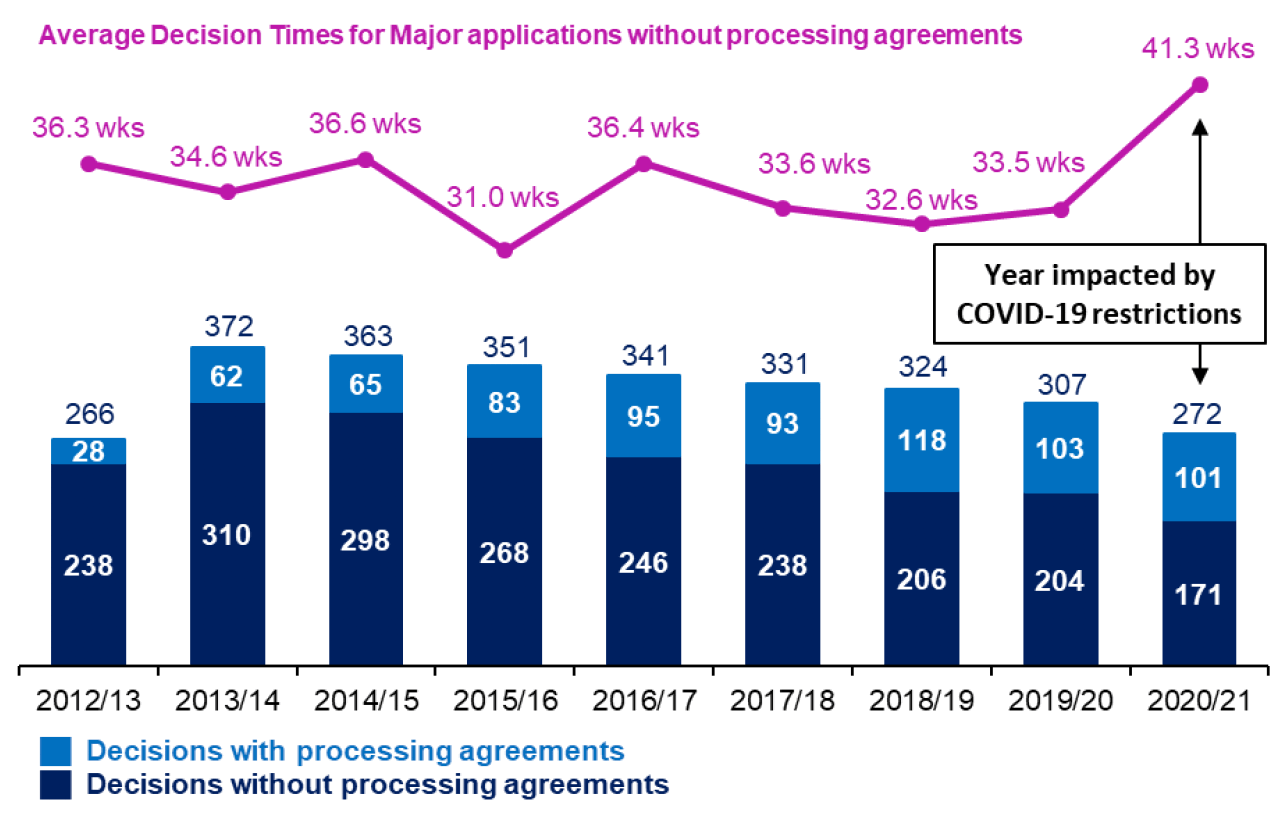
3.2. Major Housing Developments
Major Housing developments are those with 50 or more dwellings or with a site area that is or exceeds 2 hectares where the predominant use is for housing.
There were 121 major housing development applications determined in 2020/21, 54 fewer than in the previous year. The 77 not subject to processing agreements had an average decision time of 54.8 weeks, more than 17 weeks slower than the previous year.
The average decision time of 54.8 weeks was influenced by a number of applications with long decision times including five taking over three years, two of these taking more than five years (5.7 years and 9.9 years). If the two applications taking over five years are excluded the average decision time for the remaining 75 applications is 45.4 weeks, more than nine weeks quicker. If the five taking more than three years are excluded the time for the remaining 72 applications is 38.7 weeks more than 16 weeks quicker.
There were 44 Major Housing development applications with processing agreements, 54.5% (24) of these met agreed timescales that had been set between developers and local authorities.
There was also one Major Housing pre 3rd August 2009 legacy case concluded. Further details about legacy cases are in Section 11.
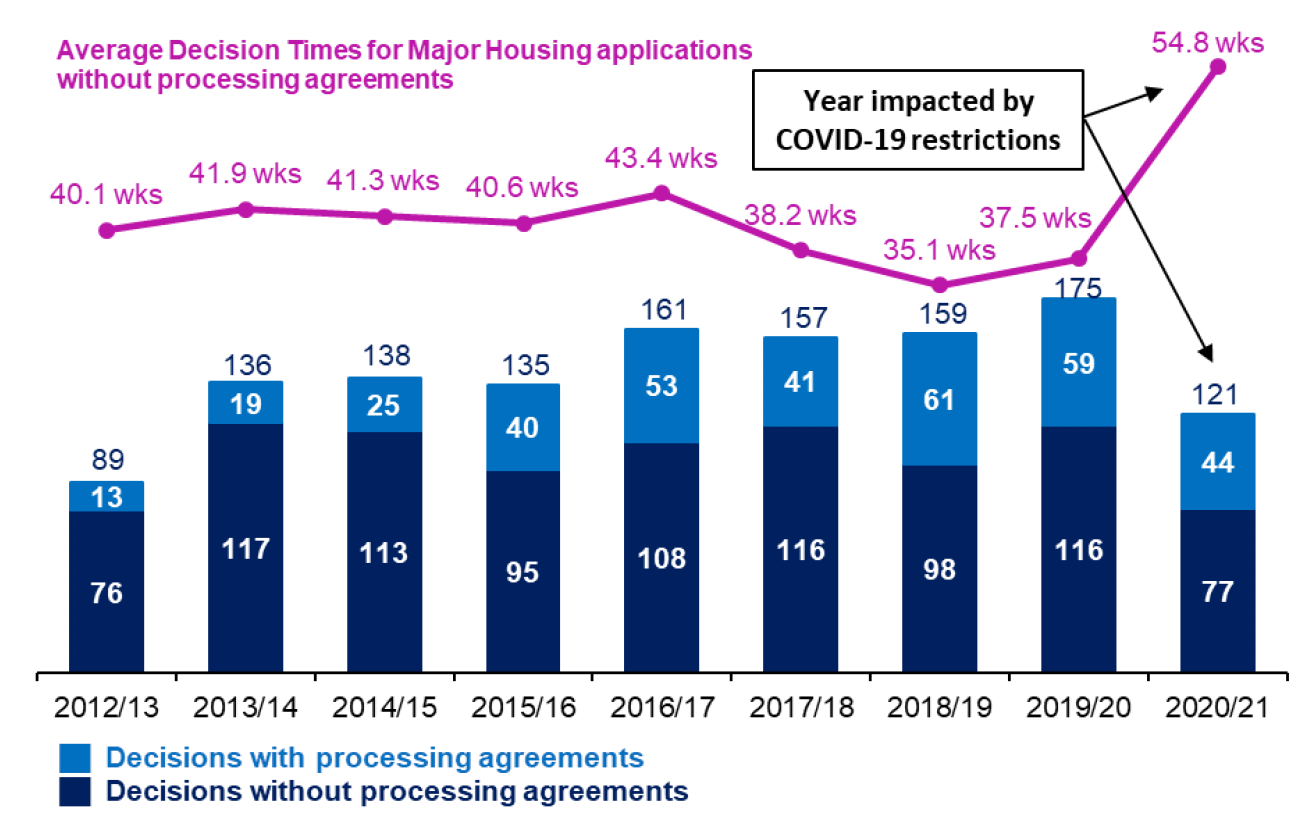
3.3. Major Business and Industry Developments
These include construction of a building or structure for any of the following: use as an office, for research and development of products or processes, for any industrial process or for use for storage or as a distribution centre.
To be classed as major the gross floor space as a result of the development must exceed 10,000 square metres or the site must exceed 2 hectares.
There were 21 Major Business and Industry development applications determined in 2020/21, eight more than in the previous year. The 15 not subject to processing agreements had an average decision time of 22.4 weeks, three days quicker than the previous year.
There were six Major business and indistry development applications with processing agreements, 83.3% (5) of these met agreed timescales that had been set between developers and local authorities.
The number of major business and industry applications is very small and so average decision times may be significantly influenced by the decision time for a single application.
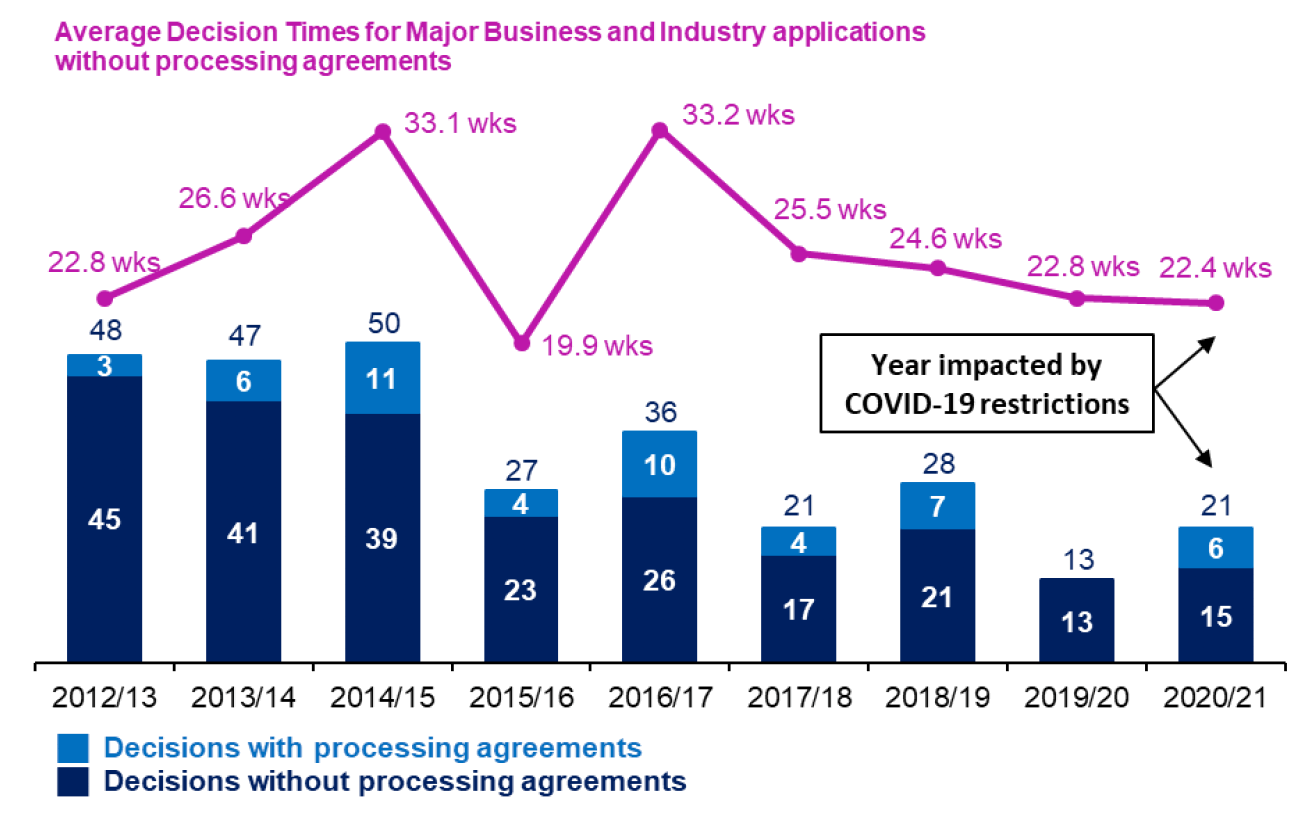
3.4. Major Electricity Generation Developments
This includes all types of electricity generating stations.
Major Electricity Generation developments are those where the capacity is or exceeds 20 megawatts.
There were 26 Major Electricity Generation development applications determined in 2020/21, six more than in the previous year. The 13 not subject to processing agreements had an average decision time of 29.3 weeks, just over a day slower than the previous year.
There were 13 Major Electricity Generation development applications with processing agreements, 53.8% (7) of these met agreed timescales that had been set between developers and local authorities.
The number of Major Electricity Generation applications is very small and so average decision times may be significantly influenced by the decision time for a single application.
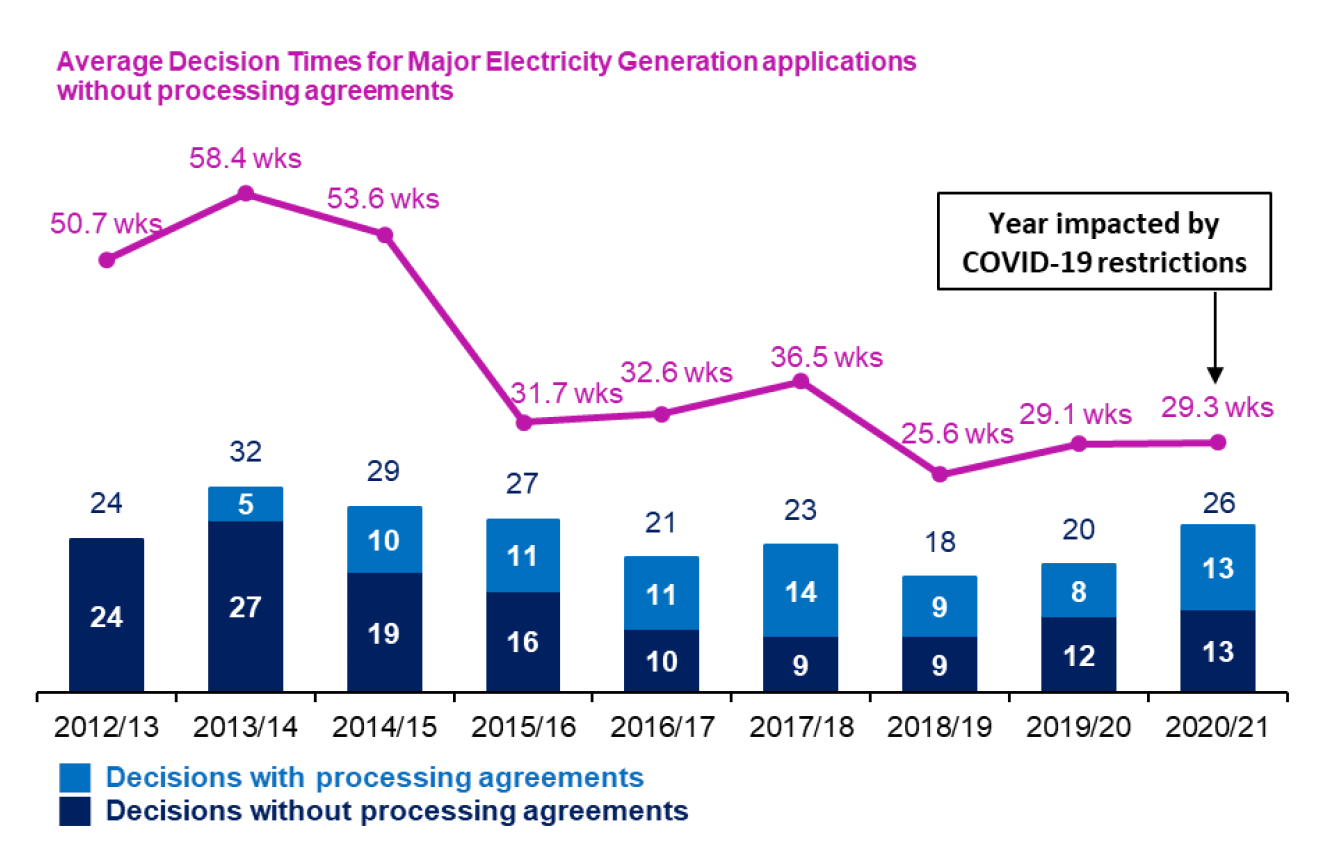
3.5. Major Other Developments
Other developments are developments not falling wholly within any other single class. They include but are not limited to retail, leisure and entertainment, education, healthcare, community facilities, transport interchanges, water and drainage developments and projects. This class also covers mixed use projects.
Major Other Developments are where the gross floor space of any building, structure or erection as a result of such development is or exceeds 5,000 square metres or the area of the site is or exceeds 2 hectares.
There were 84 Major Other Developments applications determined in 2020/21, five more than in the previous year. The 53 not subject to processing agreements had an average decision time of 29.7 weeks, over two weeks slower than the previous year.
There were 31 Major Other Developments applications with processing agreements, 51.6% (16) of these met agreed timescales that had been set between developers and local authorities.
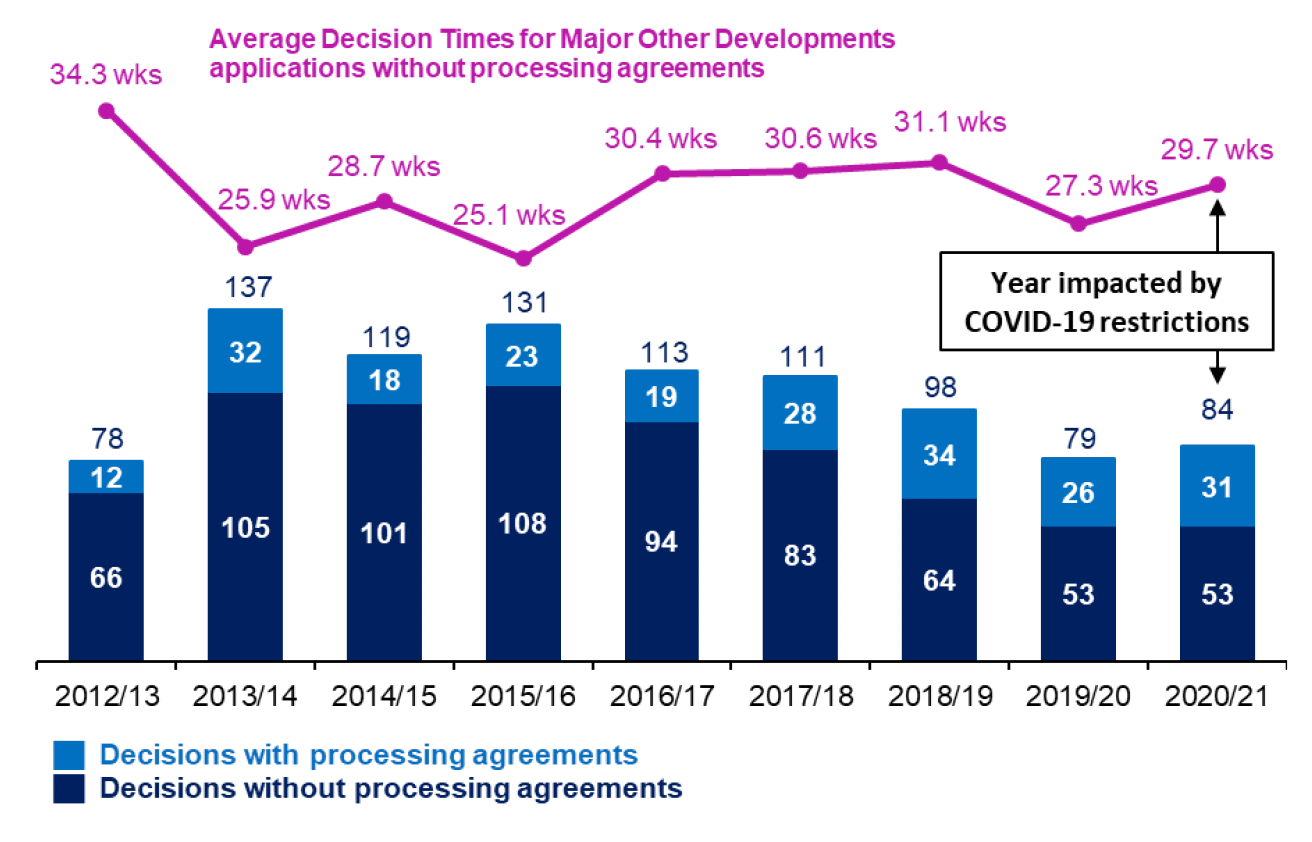
Contact
Email: planning_stats@gov.scot
There is a problem
Thanks for your feedback